This is the third of five articles that discusses teams and players the Nashville Predators should target at the 2019 Trade Deadline. In the first two installments, I covered the Ottawa Senators, with Matt Duchene and Mark Stone as targets for the Predators to acquire and sign long-term, and followed it up with the New York Rangers, in which I discussed Kevin Hayes, Adam McQuaid and Mats Zuccarello as playoff rentals they should pursue.
Related: Predators’ Trade Deadline Strategies
This installment covers the Philadelphia Flyers, a team in an interesting position at this season’s trade deadline. That position being that they could be good enough to make the postseason, yet aren’t good enough to make a deep run. It’s been a familiar position for them in recent seasons, having not been a consistent playoff team since the 2011-12 season, the last of their five consecutive playoff appearances that reached its apex with a Stanley Cup Final appearance in 2010.
Since 2012-13, they have been in the playoffs every other season, but have failed to get out of the first round each time they’ve qualified. This included a six-game loss to the Pittsburgh Penguins in 2018. The Flyers situation is bizarre because it appeared as they would be on the same trajectory as their cross-state rival and compete for Eastern Conference titles during the 2000s and 2010s.
When they drafted Claude Giroux 22nd overall in 2006, they had a core that consisted of Jeff Carter, Simon Gagne and Mike Richards. That was better than what the Penguins had when they drafted Sidney Crosby.
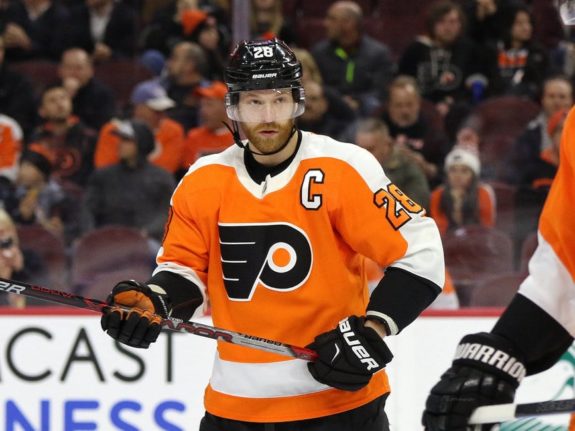
However, all three were gone by the 2011-12 season, leaving Giroux as the focal point with little high-end talent surrounding him as a 24-year-old and soon-to-be captain. Couple that with having not drafted until the third round in 2009 and 2010 and not receiving consistent goaltending since they traded away Sergei Bobrovsky (receiving next-to-nothing in return), and it’s no surprise the Flyers have lacked consistency.
This has led to them drafting high in some years – Nolan Patrick second overall in 2017 – but also not selecting until later in others. Despite this, the front office under Paul Holmgren and Ron Hextall drafted well, which included hitting on late-first and mid-round picks – Morgan Frost 27th overall in 2017, Robert Hagg 41st overall in 2013 and Carter Hart 48th overall in 2016.
This has resulted in them having a good, but not great NHL roster that’s a mix of veterans and players still on their entry-level contracts (ELCs), while also possessing a strong farm system. And that’s where we are in 2018-19.
The 2018-19 Flyers
After reaching the playoffs last season, expectations were that the Flyers would get back to them this season and possibly even compete for the division title. This expectation only grew stronger when the team signed former Flyer James van Riemsdyk to a five-year, $35 million deal in the offseason. However, they never addressed their goaltending and they limped out to a 15-20-5 record through 40 games.
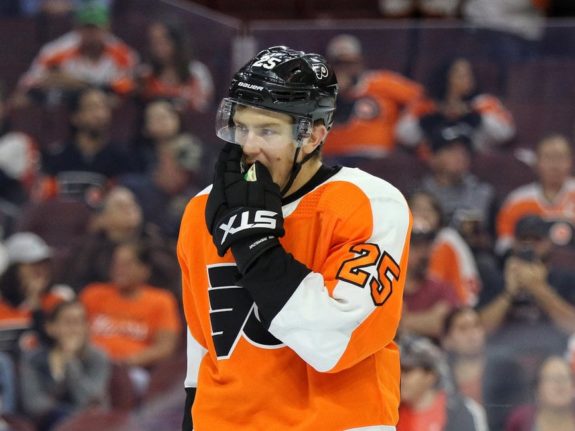
To his credit, Hextall was always open about his patient approach to building the Flyers into a long-term contender, but that wasn’t enough to save his job as he was let go on Nov. 26. At the time they were 14th in the Eastern Conference. Since the 40-game mark, they are 11-4-2 and sit sixth in the division and 11th in the conference, eight points out of the second wild card spot. Because of this, a debate has ensued about how the team should approach the trade deadline. Should they be buyers, sellers or a combination of both?
The wise decision is to be sellers at the deadline. That is because, while they may qualify for the postseason, they likely aren’t good enough to advance past the first round. Hot goaltending and streaky play can do wonders in the postseason (see 2011-12 Los Angeles Kings), but I don’t think this team is capable of making a deep run. They are currently tied for 17th in goals for, are 27th in goals against, 22nd on the power play, 27th on the penalty kill and are tied for the 26th-best save percentage.
Not to mention, they are likely to have a new head coach next season after Dave Hakstol was fired and Scott Gordon was named interim. Why not take a step back, grab at least one first-round pick via trade, allow their own first-round pick to be as high as possible and give their next coach a shot with a talented, yet relatively young, roster.
That means pending unrestricted free agents Wayne Simmonds, Michael Raffl and Phil Varone should be dealt, and even restricted free agents (RFAs) Travis Konecny, Scott Laughton and Justin Bailey should be available for the right price. Ivan Provorov and Travis Sanheim are also RFAs but are untouchables. There is also the possibility they make Radko Gudas, who has one year left on his contract, available, and Shayne Gostisbehere, also with term, has been rumored to be on the trade block.
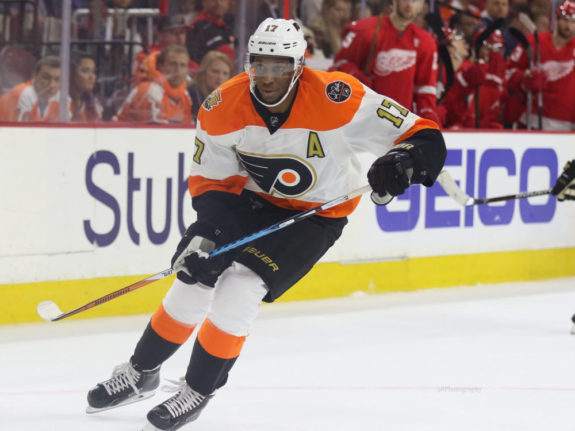
As a result, I think the Predators and Flyers could be a good match as trade partners this season. The Flyers have at least one piece who could improve the Predators, and the Predators have picks, several prospects and perhaps one young roster player who could be of interest to Philadelphia. But, it all starts with Simmonds.
Wayne Simmonds
Simmonds is a 30-year-old right-shot winger with a $3.975 million cap hit. He is a pending UFA and his contract includes a modified no-trade clause in which he submits a 12-team no-trade list. His contract is also structured such that he is paid $5 million in salary this season.
Net-Front Nightmare for Goaltenders
If there is one thing Simmonds is best known for, it’s his ability to get to the front of the net, create screens, get tips and deflections and bury rebounds. He is a five-time 25-goal scorer and has been consistent throughout his 11-season career.
In 57 games in 2018-19, he has 16 goals, 25 points, is shooting slightly below his career average at 12.5 percent and is averaging 16:32 per-game, his lowest since 2012-13. He is averaging .28 goals-per-game (G/G) and .44 points-per-game (P/G), both his lowest since 2010-11, his last season with the Kings. Both also represent the third-straight season of regression.
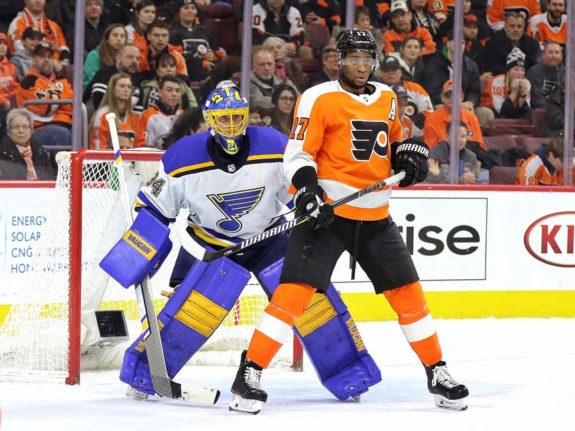
At five-on-five, Simmonds is averaging 12:59 per-game with .73 goals-per-60 (G/60) and 1.05 points-per-60 (P/60), the second-lowest of his career, and is shooting 6.89 shot-per-60 (S/60). Although he is a top-six winger, he has played on the Flyers’ third line a large portion of the season, most recently with Laughton and Patrick, also his two most-common linemates.
In 138 five-on-five minutes, the line has suspect metrics – 43.8 shots for percentage (SF%), 66.7 goals for percentage (GF%), 47.8 scoring chances for percentage (SCF%) and 46.9 high-danger chances for percentage (HDCF%). In 90 minutes without Simmonds, Laughton and Patrick have better metrics in control of shots and high-danger chances. However, their control of goals and scoring chances regress without Simmonds. All of these numbers suggest that the line isn’t good possession-wise and that Simmonds could be a cause of it.
| SF% | GF% | SCF% | HDCF% | |
| Simmonds with Laughton and Patrick | 43.8 | 66.7 | 47.8 | 46.9 |
| Laughton and Patrick without Simmonds | 49.4 | 62.5 | 47.6 | 60.7 |
It’s a similar story when he plays with Jordan Weal and van Riemsdyk, Simmonds’ second-most common linemates. That trio has played 114 five-on-five minutes together and has slightly better metrics than Simmonds’ line with Laughton and Patrick. Without Simmonds, van Riemsdyk and Weal’s metrics regress, although it’s in only 15 minutes. This suggests that Simmonds is the main reason the trio has strong metrics when together, although it is in a small sample size.
| SF% | GF% | SCF% | HDCF% | |
| Simmonds with van Riemsdyk and Weal | 51.4 | 40.0 | 56.0 | 63.2 |
| van Riemsdyk and Weal without Simmonds | 38.9 | 0.00 | 35.3 | 50.0 |
In general, the Flyers have poor metrics this season. They are sub-50 percent in control of shots, goals and scoring chances and have a 51.3 HDCF%. Considering these numbers, it’s impressive they’ve climbed up the standings the way they have.
Like other players who thrive in a net-front presence role, Simmonds excels on the power play. This season, he has five goals and three points on the man advantage, both well below his marks in recent seasons. That is sussed out in his per-60 rates. He is averaging 3:11 of power-play time per-game this season with scoring rates of 1.71 G/60, 1.02 assists-per-60 (A/60) and 2.73 P/60, all three his lowest since 2010-11.
He is attempting 12.3 S/60, in line with his career average, and is generating 19.8 individual scoring chances per-60 and 17.1 individual high-danger chances per-60, both career highs. He is, however, shooting 13.9 percent on the power play, also his lowest since 2010-11. But that’s still higher than the team’s 10.1 shooting percentage on the power play, second-lowest in the league behind only the Predators.
Simmonds plays on the top unit with Sean Couturier, Jakub Voracek, Gostisbehere and Giroux. That unit has been on the ice for seven, or 23.3 percent, of the team’s 30 power play goals. Individually, Simmonds has been on the ice for 14, or 46.7 percent, of the team’s goals scored on the man advantage.
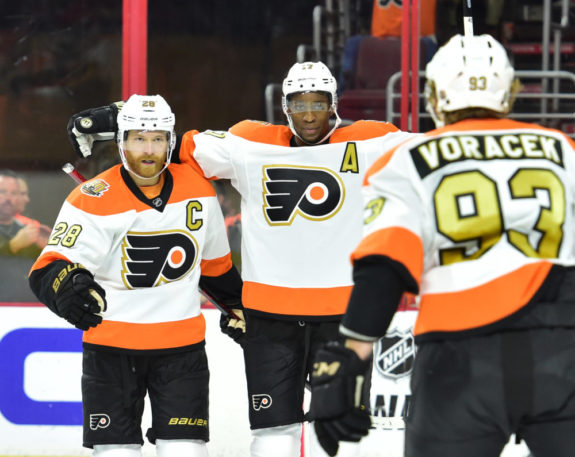
Unfortunately, he’s also been on the ice for five of the nine shorthanded goals allowed by the Flyers. Lastly, although Simmonds has been used on a consistent basis as a penalty killer in the past, including 1:30 per-game in 2016-17, he has played a total of 25 seconds shorthanded this season.
What Would He Bring to the Predators?
It’s pretty obvious how he’d fit on the Predators: they need to establish more of a net-front presence on the power play. Since they acquired Brian Boyle, the power play has been more potent with him in the net-front position. With him there, the Predators look a lot better than they did in prior weeks. They’ve generated more chances, especially high-danger ones, and, even though it hasn’t translated into many goals, the group finally looks like a real threat.
Now, imagine if the Predators acquired someone for that role with more skills, especially the eye-hand coordination and scoring touch that Simmonds possesses. In doing so, it would bump Boyle down to the second power-play unit, giving the Predators five borderline elite goal scorers on the top unit, while still icing a threatening second unit. But Simmonds would be a great fit on more than just the man advantage.
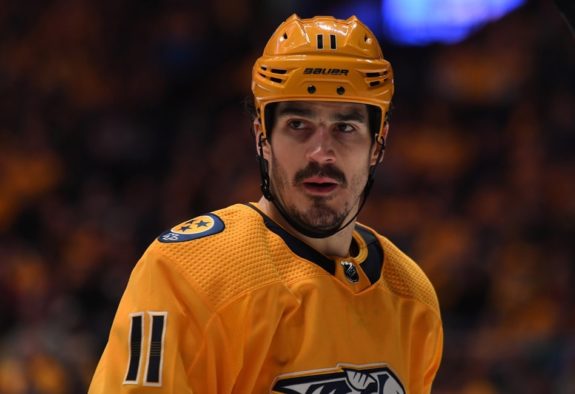
The Predators have struggled all season at getting pucks to the net and scoring goals from in close to the goaltender. According to Bill Comeau’s GameShots Event chart, the Predators attempt their shots from an average distance of 33 feet this season. The main reason for this is that they rely on their defensemen to generate a large portion of their offense. Defensemen play further from the net than forwards do, and as shot distance increases, scoring threat decreases.
Adding Simmonds would help address this “issue.” He averages 21.6 feet on attempted shots and only three of his 16 goals were scored from beyond the faceoff dots. He would help the Predators become more of a threat when deployed. His ability to establish screens and generate tips would help the defensemen convert on their attempts to get pucks to the net. But he would also help out his fellow forwards by creating space in front of the net to allow them to get the puck to the net.
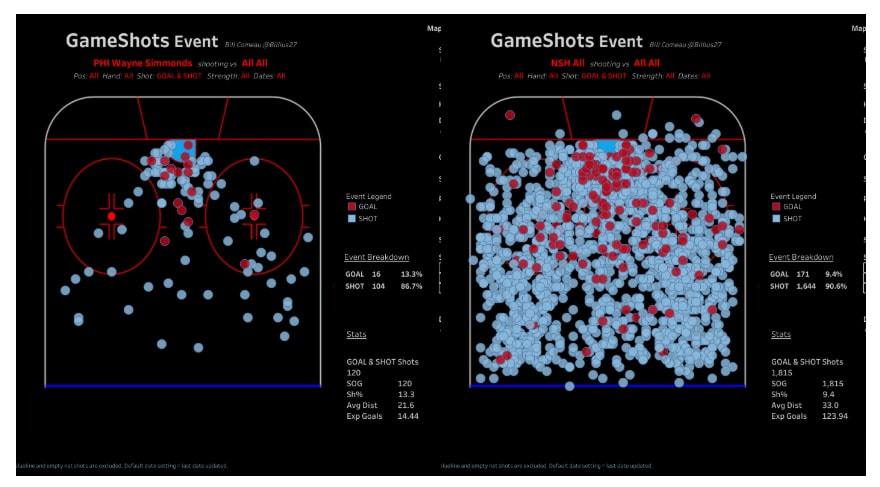
Basically, he’s the player the Predators need when he’s performing to his potential. He would provide offense from an area they have struggled to this season and could boost their power play. He has also been a strong two-way forward in his career, although he’s struggled away from the puck in recent seasons. He has a minus-six turnover margin this season and has a plus/minus of minus-16, his third straight season in the negative teens.
What Would He Cost?
It’s interesting what Predators general manager David Poile would part with to acquire Simmonds, likely only a playoff rental given his age and his desire to capitalize on his next contract considering he’s been underpaid the entirety of his current deal. It’s been rumored that the Flyers want a young NHL-ready forward in exchange for dealing one of their prominent players. The Flyers would likely ask about Eeli Tolvanen, but he shouldn’t be moved unless it’s for a player with term left or someone Poile has intentions of signing to a new deal, like Duchene or Stone.
That leads me to 22-year-old Kevin Fiala. He is having a good season with nine goals and 31 points and would likely be more productive on a team that can ensure him top-six minutes. He is also an RFA this summer as he’s on the last year of his ELC.
Is Acquiring Simmonds a Good Idea?
The problem with trading for Simmonds is that he has been on a negative trajectory for three seasons now. He’s not scoring goals or generating chances like he has in past seasons. He’s not converting on the power play and has struggled defensively. Is that the result of poor team play, anxiety about being traded and becoming a free agent or is it an aging curve? It’s hard to tell, and parting with valuable assets for a player who may not contribute much is a big risk.
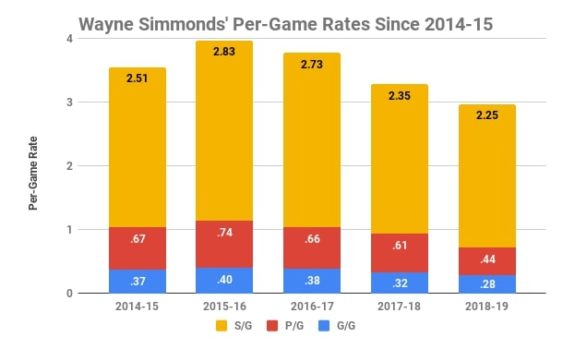
The Predators have been connected to Simmonds for a long time. They’ve needed a net-front presence the entire season and the league knows it. Typically, where there’s smoke, there’s fire in these situations. Now, that doesn’t mean the trade is inevitable. The Predators will lose a bidding war with most contenders unless they are willing to part with Tolvanen or Dante Fabbro, and it’s not worth giving up either prospect for a rental.
That’s why I’m not certain this trade will happen. If Poile won’t move either of his top prospects for a rental, and he shouldn’t, he’s left with draft picks, second-tier prospects and Fiala. If Flyers GM Chuck Fletcher requires Fiala to get the deal done, Poile should walk away. It’s simply not worth losing a former first-round pick who is cost controllable for at most three months of Simmonds, especially when Simmonds has struggled this season.
That being said, he remains a good skater with soft hands and a knack of going to the scoring areas of the ice. His addition would give the Predators scoring depth, something they need this season, as his arrival would either bump someone down to the third line or he himself would be slotted on that line. But it all comes down to what Fletcher will require for Simmonds.
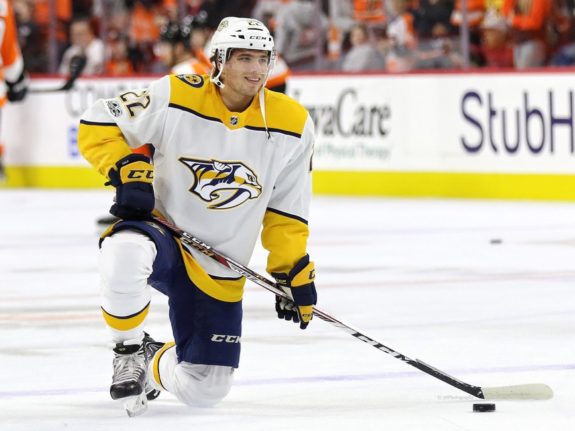
If it’s a first-round pick and a second-tier prospect like forwards Yakov Trenin and Anthony Richard or defensemen Alexandre Carrier and Frédéric Allard, all NHL-ready, then the trade may be worth it. Poile parted with a bigger package for Ryan Hartman last season and he didn’t have Simmonds’ upside, even if he was an RFA. However, if it requires more than that package, there’s no deal to be made.
*All stats from Hockey-Reference and Natural Stat Trick